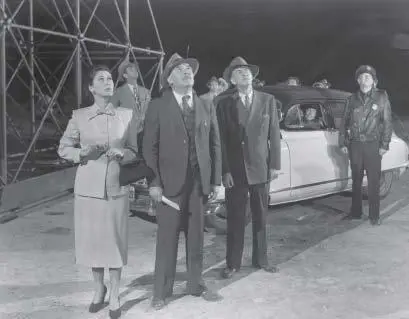It surprised me that in thirty-plus years of orbiting science labs, so little work has been done. Is it institutional conservatism? Male squeamishness over obstetrical issues? Ronca thought it was more a case of priority than prudery. “We don’t know much about the effects of weightlessness on any of the body’s basic systems—bone, muscle, cardiovascular. We know even less about the brain. Reproduction just has not been high on the list.”
And now the funding is gone. NASA’s life sciences program has been pretty well gutted. I almost wrote “is dead in the water,” then caught myself. The last significant NASA mammalian biology study flew aboard Space Shuttle Columbia in 2003. The rats perished along with the crew. There was nothing anyone could do to save them, though the same cannot necessarily be said for the astronauts.
13. WITHERING HEIGHTS
Bailing Out from Space

The Perris SkyVenture vertical wind tunnel is a hurricane in a can. Air rushes at 100-plus miles per hour through the core of a cylindrical building that resembles an air-traffic control tower. It’s probably not the tallest building in Perris—a sprawl of malls and tract homes a couple hours out from Los Angeles—but it feels like it. Up near the top, where the controllers would be sitting, a set of doors open onto the column of wind. Customers lean into the air, open their arms and legs as they fall, and are lifted off their feet. It’s the sensation of free fall with no danger or rush: skydiving with its balls removed. If it is your first visit, a staff person helps steady you in case you drift upward and panic and bounce off the walls like an air-popped kernel.
Today is Felix Baumgartner’s first visit to SkyVenture, but no one is holding on to him. Baumgartner, a photogenic forty-one-year-old Austrian, is a high-profile skydiver and BASE [80] BASE stands for Building Antenna (radio tower) Span (bridge) Earth (cliff)—the four dangerously low things they parachute from. According to a 2007 Journal of Trauma study, the death and injury rate for BASE jumping is five to eight times that of skydiving. Though it’s lower than you’d think: 9 out of 20,850 jumps off Norway’s Kjerag Massif over a ten-year span (run of years) have ended in death.
jumper. You can go on YouTube and watch Baumgartner jump off the outstretched right arm of the enormous Christ statue in Rio de Janeiro or, more prosaically, the roof of the Warsaw Marriott. For most of his jumps he wears a skydiver’s jumpsuit. In the Marriott video, he’s dressed in business casual. He’s done this to pass through the lobby without arousing suspicion, but the impression it gives, as you watch him walk to the edge of the roof in his tie and dress shirt, is that jumping off buildings is just another day on the job for Felix Baumgartner.
This evening finds Baumgartner dressed like an astronaut. He has traveled to Perris this week as part of the Red Bull Stratos Mission. The mission’s aims are twofold. I’m mainly interested in the aeromedical side of it. Baumgartner is testing a modified emergency escape suit made by the David Clark Company, makers of spacesuits since the days of the Mercury space program. [81] NASA turned to David Clark because of the company’s experience with rubberized fabric. “A spacesuit is a rubberized anthropomorphic bag,” says retired Air Force master parachutist and escape-system tester Dan Fulgham. “Well, we didn’t have any experience working with rubber bags. We came across the David Clark Company in Worcester, Massachusetts. They were producing twenty gross per month of bras and girdles for Sears, Roebuck.” Fulgham has fond memories of driving up to Worcester for meetings and catching glimpses of fit models wandering around in the back. The contract for the Apollo lunar landing suits went to International Latex, which later became Playtex. This didn’t get a lot of airplay at the time.
Since 1986, when Space Shuttle Challenger exploded 72 seconds after launch, astronauts have worn pressure suits not just while spacewalking, but during launch, reentry, and landing—the chanciest parts of a flight. Baumgartner will wear it to keep himself alive during a “space dive” from 23 miles (120,000 feet) up. (It’s not technically space—space begins at 62 miles—but it’s close; atmospheric pressure at that altitude is less than one one-hundredth of what it is at sea level.) The jump—slated for summer or fall 2010 in an undisclosed locale—will provide escape-system engineers with hard-to-come-by information about the behavior of a falling body in a pressurized suit in extremely thin air and the reactions of that body to transonic and supersonic speeds. Because there’s so little air resistance up there, Baumgartner is expected to reach 690 miles per hour, rather than the 120-miles-per-hour terminal velocity of a typical free fall at lower altitude. No one has ever bailed out in a spaceflight emergency, and it isn’t clear how best to do it safely in all phases of flight.
Baumgartner says he’s proud of the contributions he’ll be making to safer space travel, but he’s primarily interested in breaking records. The current skydiving altitude record is 102,800 feet. That record was also set by a man testing high-altitude survival gear. In 1960, in a project called Excelsior, Air Force captain Joe Kittinger stepped from an open-top steel gondola carried by a helium balloon and skydived, in a partial pressure suit, 19 miles to the ground. He was testing a multistage parachute system. In his oral history transcript on file at the New Mexico Museum of Space History, Kittinger says he broke the sound barrier while free-falling, but he did not carry the equipment needed to make the record official. Thus Baumgartner will likely also make the record books as the first human to reach supersonic speed without a jet or other conveyance.
The Stratos Mission is funded in large part by Baumgartner’s corporate sponsor, Red Bull. Sponsoring extreme athletes is Red Bull’s way of telling the world that the brand stands not just for caffeinated pop, but for, as the press releases say, “pushing limits” and “making the impossible happen.” Teenage boys with little hope of becoming pro skateboarders or record-breaking BASE jumpers can nonetheless drink the drink and feel the feeling. NASA might do well to adopt the Red Bull approach to branding and astronautics. Suddenly the man in the spacesuit is not an underpaid civil servant; he’s the ultimate extreme athlete. Red Bull knows how to make space hip.
Baumgartner looks the part. To quote an industrial cutting materials pamphlet I saw not long ago, he has very good bulk and edge-line toughness. He looks like Mark Wahlberg and sounds like Arnold Schwarzenegger, but he’s cooler than either. He’s in the wind tunnel now, holding facedown in the classic spread-eagle free-fall position. The spacesuit has been pressurized. I count ten charging red bulls. The logos appear vertically on the suit’s arms and legs, making some of the bulls appear to be executing a skydiving move called the sit-fly. Baumgartner reaches around to his front to get a feel for the placement of the ripcord. (He can’t see it, because the spacesuit prevents him from bending his neck.) Now he straightens his legs, assessing the suit’s flexibility. This adds surface area for the wind to push against, and he shoots up ten feet, and then stops, hovering above a group of onlookers like a Thanksgiving parade balloon.
Not since Joe Kittinger’s day have escape suits and emergency parachute systems been tested in high-altitude skydives. (It’s too expensive. Baumgartner will ascend in a pressurized capsule suspended below a huge—26 million cubic feet—helium balloon.) They probably should be. With so little air resistance, it’s hard to control one’s body position. Imagine holding your hand in the wind outside a car window at 60 miles per hour. By angling it slightly to present more or less surface to the wind, you can feel obvious shifts in direction and pressure. If the car were traveling 23 miles in the air, you’d feel none of that. It’s harder for skydivers—or astronauts or space tourists ejecting at high altitude—to stop a spin, and a poorly designed suit could make the situation worse. Baumgartner will need to free-fall for about 30 seconds before he gains enough speed to generate the wind force needed to control his position—or to benefit from the emergency stabilization chute he’ll carry.
Читать дальше













